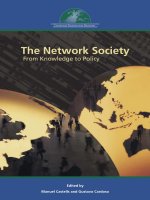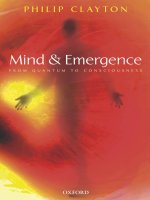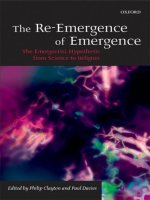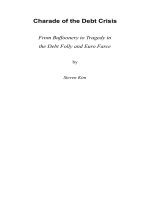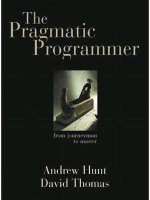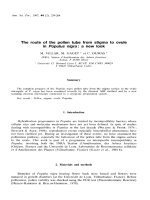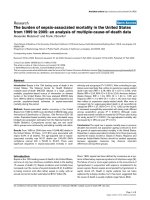- Trang chủ >>
- Khoa Học Tự Nhiên >>
- Vật lý
The universe within: from quantum to cosmos
Bạn đang xem bản rút gọn của tài liệu. Xem và tải ngay bản đầy đủ của tài liệu tại đây (5.68 MB, 976 trang )
www.pdfgrip.com
THE MASSEY LECTURES SERIES
The Massey Lectures are co-sponsored by
CBC Radio, House of Anansi Press, and
Massey College in the University of
Toronto. The series was created in honour
of the Right Honourable Vincent Massey,
former Governor General of Canada, and
was inaugurated in 1961 to provide a forum
on radio where major contemporary
thinkers could address important issues of
our time.
This book comprises the 2012 Massey
Lectures, “The Universe Within: From
Quantum to Cosmos,” broadcast in
November 2012 as part of CBC Radio’s
Ideas series. The producer of the series
was Philip Coulter; the executive producer
was Bernie Lucht.
NEIL TUROK
www.pdfgrip.com
Neil Turok is one of the world’s leading
theoretical physicists and a renowned
educational innovator. Director of the
Perimeter Institute for Theoretical Physics,
he was formerly a professor of physics at
Princeton and held a Chair of Mathematical
Physics at Cambridge. As well as
developing fundamental theories of the
cosmos, he has led efforts to determine
their predictions and to test them through
observation. With Stephen Hawking, he
developed the Hawking–Turok instanton
solutions describing the birth of inflationary
universes. With Paul Steinhardt, he
developed a cyclic universe scenario,
described in their critically acclaimed book
Endless Universe: Beyond the Big Bang —
Rewriting Cosmic History. In 1992, Turok
was awarded the James Clerk Maxwell
medal of the UK Institute of Physics and, in
2008, a prestigious TED Prize. Born in
www.pdfgrip.com
South Africa, Turok founded the African
Institute for Mathematical Sciences
(AIMS), a pan-African network of centres
for education and research. This work has
been recognized by awards from the World
Summit on Innovation and
Entrepreneurship (WSIE) and the World
Innovation Summit on Education (WISE).
Turok lives in Waterloo, Ontario, Canada.
www.pdfgrip.com
ALSO BY NEIL TUROK
Endless Universe: Beyond the Big Bang —
Rewriting Cosmic History (with Paul J.
Steinhardt)
www.pdfgrip.com
THE UNIVERSE
WITHIN
From Quantum to Cosmos
NEIL TUROK
www.pdfgrip.com
Copyright © 2012 Neil Turok and Canadian Broadcasting
Corporation
All rights reserved. No part of this publication may be
reproduced or transmitted in any form or by any means,
electronic or mechanical, including photocopying,
recording, or any information storage and retrieval
system, without permission in writing from the
publisher.
Distribution of this electronic edition via the Internet or
any other means without the permission of the publisher
is illegal. Please do not participate in electronic piracy of
copyrighted material; purchase only authorized
electronic editions. We appreciate your support of the
author’s rights.
This edition published in 2012 by
House of Anansi Press Inc.
110 Spadina Avenue, Suite 801
Toronto, ON, M5V 2K4
Tel. 416-363-4343
Fax 416-363-1017
www.houseofanansi.com
www.pdfgrip.com
Library and Archives Canada Cataloguing in Publication
Turok, Neil
The universe within : from quantum to cosmos / Neil
Turok.
(CBC Massey lecture series)
Includes bibliographical references and index.
ISBN: 978-1-77089-225-5
1. Cosmology—Popular works. 2. Discoveries in science.
3. Research—Social aspects. I. Title. II. Series: CBC
Massey
lecture series
QB982.T87 2012 523.1 C2012-902895-9
Library of Congress Control Number: 2012938339
ISBN: 978-1-77089-017-6 (US)
Cover design: Bill Douglas
Ccover images: (Brain) science picture co/science
faction/Getty; (Universe) clearviewimages/iStockphoto
www.pdfgrip.com
We acknowledge for their financial support of our
publishing program
the Canada Council for the Arts, the Ontario Arts
Council, and the Government of Canada through the
Canada Book Fund.
www.pdfgrip.com
To my parents
www.pdfgrip.com
AUTHOR’S NOTE
IN THIS BOOK, I try to connect our
progress towards discovering the
physical basis of reality with our
own character as human beings.
This is not an academic text. I
describe some of physics’ biggest
ideas and how they were
discovered, but I make no serious
attempt to provide a balanced
history or to properly apportion
credit. Instead, I use my personal
experience as
a common thread,
www.pdfgrip.com
along with accounts of people,
times, and places that seem special
to me. The personalities are
interesting, but I use them mainly
as illustrations of what is possible
and of how much more capable we
are than we realize. I am not a
philosopher, historian, or an art or
literary critic, but I draw on each of
these subjects to illustrate the
circumstances and the
consequences of our deepening
knowledge. This is a vast subject,
and I apologize for my limited
www.pdfgrip.com
perspective and for my many
arbitrary choices.
My goal is to celebrate our
ability to understand the universe,
to recognize it as something that
can draw us together, and to
contemplate what it might mean for
our future.
I have benefitted from the
insights and mentorship of
wonderful colleagues, too numerous
to mention. I have been equally
inspired by many non-scientists,
people who through their lives
www.pdfgrip.com
exemplify what it means to be
human. Our science and our
humanity are two sides of the same
coin. Together, they are the means
for us to live up to the opportunity
of our existence.
www.pdfgrip.com
ONE
MAGIC THAT WORKS
“Happy is the man who can recognize
in the work of today a connected
portion of the work of life,
and an embodiment of the work of
Eternity.”
— James Clerk Maxwell1
WHEN I WAS THREE years old, my
father was jailed for resisting the
apartheid regime in South Africa.
Shortly afterward,
my mother was
www.pdfgrip.com
also jailed, for six months. During
that time, I stayed with my
grandmother, who was a Christian
Scientist. My parents weren’t
religious, so this was a whole new
world to me. I enjoyed the singing,
and especially the Bible: I loved the
idea of a book that held the answer
to everything. But I didn’t want a
big Bible; I wanted a little Bible
that I could carry around in my
pocket.
So I campaigned endlessly for
my grandmother to buy me the
www.pdfgrip.com
smallest possible Bible. When she
finally did, I took it everywhere. I
couldn’t read yet, but that didn’t
matter to me. What I most wanted,
even at that early age, was to
capture and hold the truth, with the
certainty and love that it brings.
My father was charged with
sabotage and was fortunate to be
released after only three and a half
years. Others who had been tried
on lesser charges were given life
terms. On my father’s release from
prison, he was held under house
www.pdfgrip.com
arrest but escaped and fled north to
East Africa. We followed him there
and lived in Tanzania for several
years before moving to London,
England. There we joined a small
community of exiles trying to
survive in unfamiliar, damp, and
gloomy surroundings. Nevertheless,
my parents always held firm to their
ideas. “One day,” they told my
brothers and me, “there will be a
great change, and South Africa will
be free.”
It was hard for us to believe
www.pdfgrip.com
them. Throughout the 1970s and
1980s, as I was growing up in
England, going to high school and
then university, the situation back
home seemed hopeless. The
apartheid regime was popular with
the all-white electorate, and it had
powerful allies overseas. South
Africa even developed and tested
nuclear weapons. The tiny handful
of organized dissidents were easily
captured and imprisoned. Protests
by school students in Soweto were
ruthlessly crushed, and the police
www.pdfgrip.com
state took an iron grip.
But then, quite suddenly,
everything changed.
The apartheid system was
founded on a profoundly wrong
premise — that black people are
inferior to white people — and this
brought its demise. Within the
country, the aspirations of the black
majority could no longer be
contained. External protests also
gathered impact as more and more
countries boycotted South Africa. In
1993, with Nelson Mandela’s
www.pdfgrip.com
negotiated release from prison, the
mood turned. The white minority
accepted that apartheid was no
longer sustainable, and that the
future would have to involve
universal suffrage and greater
opportunities for all. The change in
South Africa was wrought by a
simple but undeniable idea: justice
— the principle of fairness, equity,
and human rights that protects us
all. Justice is a cause shared across
races, cultures, and religions; it is
powerful enough to win many
www.pdfgrip.com
people’s lifetime commitment and,
for some, commitment of their
lives. If you had to point to the
driver of change in South Africa, it
would be this one simple notion
that prevailed over all the privilege,
wealth, and weaponry that the
apartheid regime amassed.
My parents were right. A good
idea can change the world.
TODAY, WE LIVE IN a worried world
that seems short of good ideas. We
are confronted by challenges that
www.pdfgrip.com
can feel overwhelming: financial
instability, overconsumption and
pollution, energy and resource
shortages, climate change, and
growing inequality. All of these
problems were created by humans,
and they are all solvable. Yet we
seem to be locked in a culture of
short-term thinking, of the quick fix
and the fast buck. Whereas what
each of these problems really needs
for its solution is consistent,
principled, far-sighted actions
extending over many years.
www.pdfgrip.com
We’re reaching the limits of
existing technologies and natural
resources. We are in danger of
losing our sense of optimism. Can
we find smarter ways to manage
our planet? Can we make the
discoveries that will open up a
bright future? Who are we, after all?
Are we just the product of a process
of random mutation and natural
selection, now reaching its
terminus? Or are we potentially the
initiators of a new evolutionary
stage, in which life may rise to a
www.pdfgrip.com
